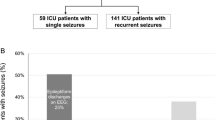Abstract
Purpose
Our aim was to investigate the prevalence, risk factors, and impact on outcome of nonconvulsive seizures (NCSz), nonconvulsive status epilepticus (NCSE), and periodic epileptiform discharges (PEDs) in surgical intensive care unit (SICU) patients with continuous electroencephalography (cEEG) monitoring.
Methods
This was a retrospective study of SICU patients who underwent cEEG monitoring for altered mental status over a 6-year period. We report the frequency of NCSz (including NCSE) and PEDs on cEEG. The primary outcome was death or severe disability at hospital discharge. Multivariable logistic regression was used to identify whether NCSz (including NCSE) and PEDs were independently associated with poor outcome (death, vegetative state or severe disability).
Results
Of 154 patients, the mean age was 64 ± 14 years old, and 40 % were women. The majority of patients were admitted following abdominal surgery (36 %) and liver transplantation (24 %). Sepsis developed in 100 (65 %) patients. Sixteen percent (n = 24) had NCSz [including 5 % (N = 8) with NCSE], and 29 % (N = 45) had PEDs. All eight patients with NCSE were septic. Clinical seizures prior to cEEG and coma were more common among patients who developed NCSz or NCSE compared to patients without NCSz or NCSE (70 vs. 27 %; p < 0.01; 75 vs. 52 %; p = 0.046 and 63 vs. 34 %; p = 0.09, respectively). NCSzs (including NCSE) were independently associated with poor outcome (20 vs. 3 %, OR 10.4, 95 % CI 1.0–53.7; p = 0.039).
Conclusion
In this retrospective study of SICU patients with cEEG monitoring for altered mental status, NCSz and periodic discharges were frequent and NCSz were independently associated with poor outcome. NCSz were more common when clinical seizures occurred before cEEG.


Similar content being viewed by others
References
Claassen J, Mayer SA, Hirsch LJ (2005) Continuous EEG monitoring in patients with subarachnoid hemorrhage. J Clin Neurophysiol 22:92–98
Pandharipande P, Cotton BA, Shintani A et al (2007) Motoric subtypes of delirium in mechanically ventilated surgical and trauma intensive care unit patients. Intensive Care Med 33:1726–1731. doi:10.1007/s00134-007-0687-y
Vespa PM, Miller C, McArthur D et al (2007) Nonconvulsive electrographic seizures after traumatic brain injury result in a delayed, prolonged increase in intracranial pressure and metabolic crisis. Crit Care Med 35:2830–2836. doi:10.1097/01.CCM.0000295667.66853.BC
Pandharipande P, Cotton BA, Shintani A et al (2008) Prevalence and risk factors for development of delirium in surgical and trauma intensive care unit patients. J Trauma 65:34–41. doi:10.1097/TA.0b013e31814b2c4d
Claassen J, Jetté N, Chum F et al (2007) Electrographic seizures and periodic discharges after intracerebral haemorrhage. Neurology 69:1356–1365. doi:10.1212/01.wnl.0000281664.02615.6c
Carrera E, Claassen J, Oddo M et al (2008) Continuous electroencephalographic monitoring in critically ill patients with central nervous system infections. Arch Neurol 65:1612–1618. doi:10.1001/archneur.65.12.1612
Oddo M, Carrera E, Claassen J et al (2009) Continuous electroencephalography in the medical intensive care unit. Crit Care Med 37:2051–2056. doi:10.1097/CCM.0b013e3181a00604
Lat I, McMillian W, Taylor S et al (2009) The impact of delirium on clinical outcomes in mechanically ventilated surgical and trauma patients. Crit Care Med 37:1898–1905. doi:10.1097/CCM.0b013e31819ffe38
Kamel H, Betjemann JP, Navi BB et al (2012) Diagnostic yield of electroencephalography in the medical and surgical intensive care unit. Neurocrit Care. doi:10.1007/s12028-012-9736-7
Brown CVRC, Daigle JBJ, Foulkrod KHK et al (2011) Risk factors associated with early reintubation in trauma patients: a prospective observational study. J Trauma 71:32–37. doi:10.1097/TA.0b013e31821e0c6e
Claassen J, Mayer SA, Kowalski RG et al (2004) Detection of electrographic seizures with continuous EEG monitoring in critically ill patients. Neurology 62:1743–1748
Young GB, Jordan KG, Doig GS (1996) An assessment of nonconvulsive seizures in the intensive care unit using continuous EEG monitoring: an investigation of variables associated with mortality. Neurology 47:83–89
Towne AR, Waterhouse EJ, Boggs JG et al (2000) Prevalence of nonconvulsive status epilepticus in comatose patients. Neurology 54:340–345
Vespa PM, O’Phelan K, Shah M et al (2003) Acute seizures after intracerebral haemorrhage: a factor in progressive midline shift and outcome. Neurology 60:1441–1446
Hirsch LJ, Claassen J, Mayer SA, Emerson RG (2004) Stimulus-induced rhythmic, periodic, or ictal discharges (SIRPIDs): a common EEG phenomenon in the critically ill. Epilepsia 45:109–123
Chong DJ, Hirsch LJ (2005) Which EEG patterns warrant treatment in the critically ill? Reviewing the evidence for treatment of periodic epileptiform discharges and related patterns. J Clin Neurophysiol 22:79–91
Vincent JLJ, Moreno RR, Takala JJ et al (1996) The SOFA (Sepsis-related Organ Failure Assessment) score to describe organ dysfunction/failure. On behalf of the working group on sepsis-related problems of the European society of intensive care medicine. Intensive Care Med 22:707–710
Claassen J, Taccone FS, Horn P et al (2013) Recommendations on the use of EEG monitoring in critically ill patients: consensus statement from the neurointensive care section of the ESICM. Intensive Care Med. doi:10.1007/s00134-013-2938-4
Jennett B, Bond M (1975) Assessment of outcome after severe brain damage. Lancet 1:480–484. doi:10.1016/S0140-6736(75)92830-5
Rossetti AO, Oddo M, Logroscino G, Kaplan PW (2010) Prognostication after cardiac arrest and hypothermia: a prospective study. Ann Neurol 67:301–307. doi:10.1002/ana.21984
Jette N, Claassen J, Emerson RG, Hirsch LJ (2006) Frequency and predictors of nonconvulsive seizures during continuous electroencephalographic monitoring in critically ill children. Arch Neurol 63:1750–1755. doi:10.1001/archneur.63.12.1750
Polito A, Eischwald F, Le Maho A-L et al (2013) Pattern of brain injury in the acute setting of human septic shock. Crit Care 17:R204. doi:10.1186/cc12899
Conflicts of interest
None of the authors has any competing interest to declare.
Author information
Authors and Affiliations
Corresponding author
Additional information
Take-home message: Nonconvulsive seizures occur in 16 % of patients admitted to a surgical ICU for post-operative care with altered mental status and are associated with poor outcome at discharge. Risk factors include coma and clinical seizures prior to cEEG monitoring.
Electronic supplementary material
Below is the link to the electronic supplementary material.
Rights and permissions
About this article
Cite this article
Kurtz, P., Gaspard, N., Wahl, A.S. et al. Continuous electroencephalography in a surgical intensive care unit. Intensive Care Med 40, 228–234 (2014). https://doi.org/10.1007/s00134-013-3149-8
Received:
Accepted:
Published:
Issue Date:
DOI: https://doi.org/10.1007/s00134-013-3149-8




